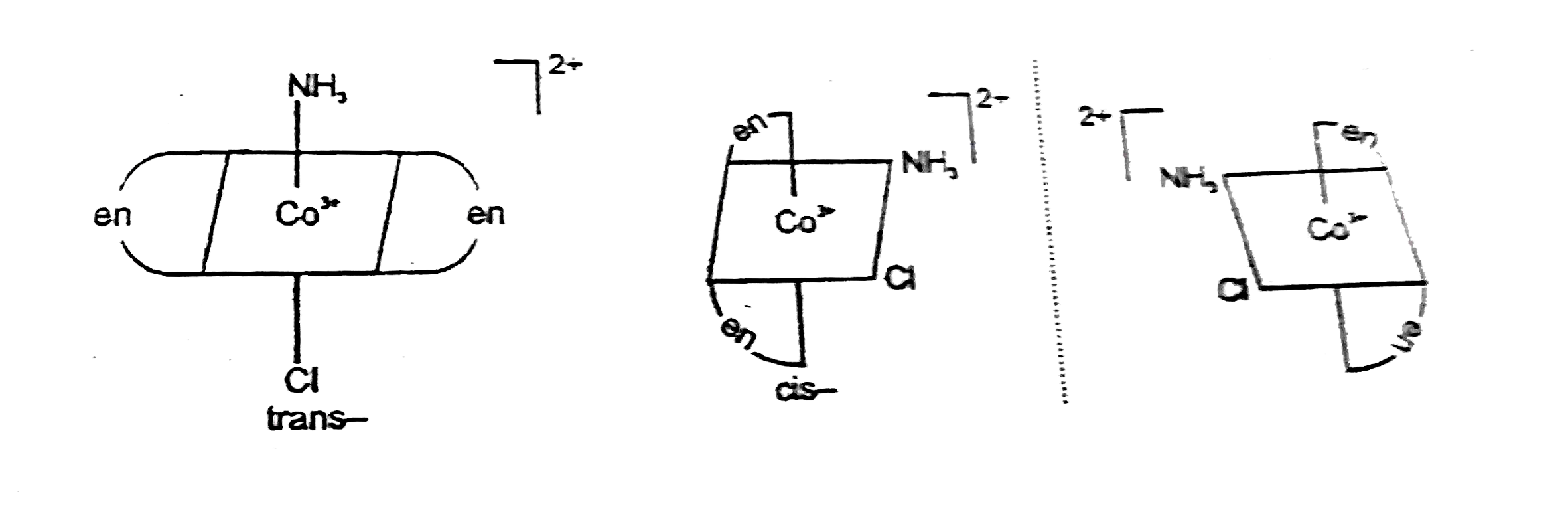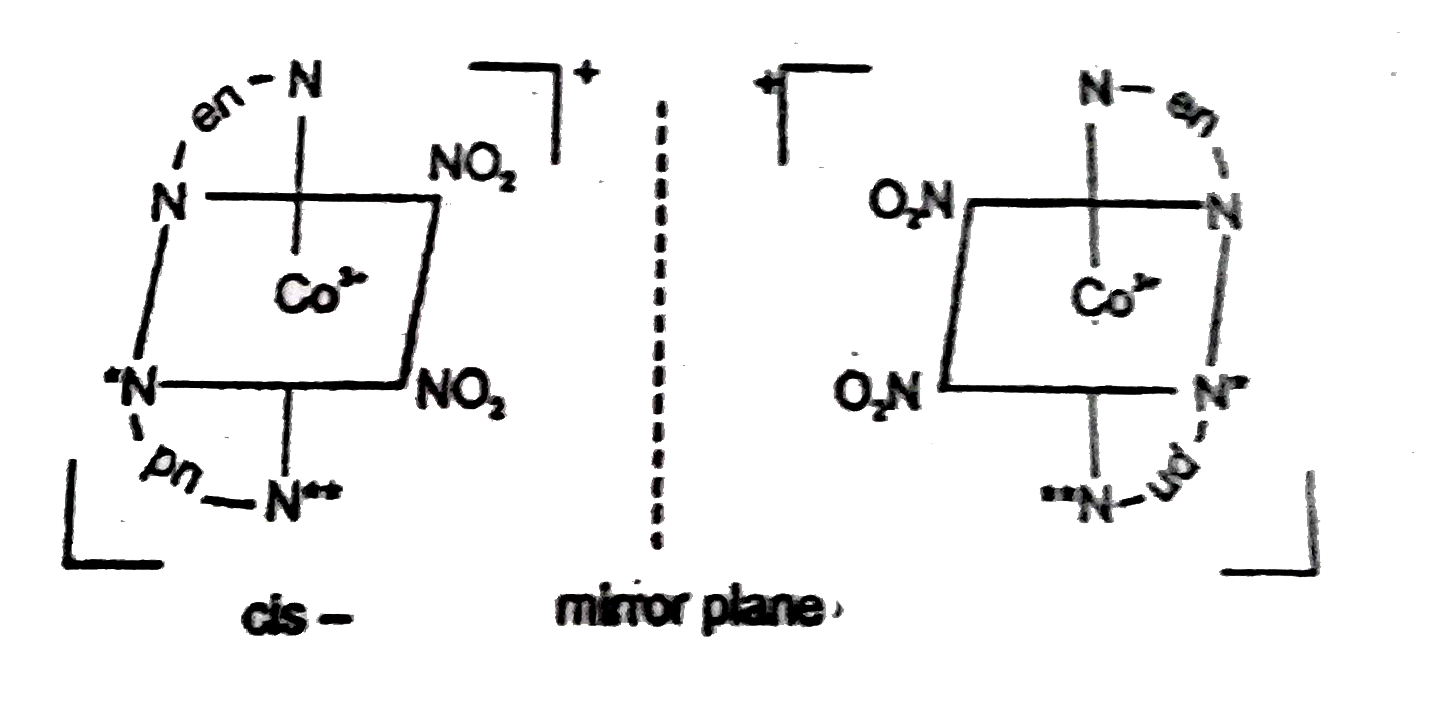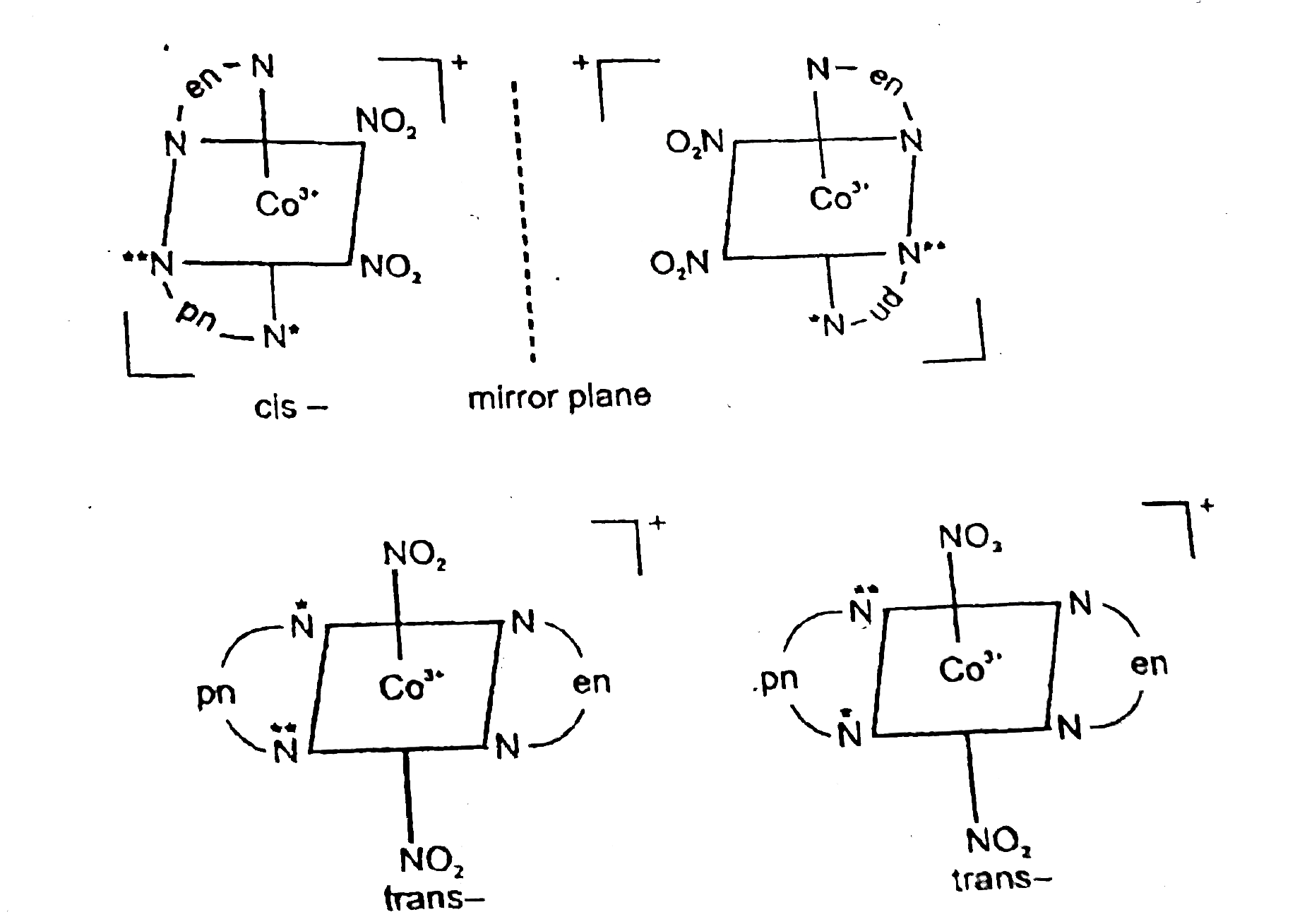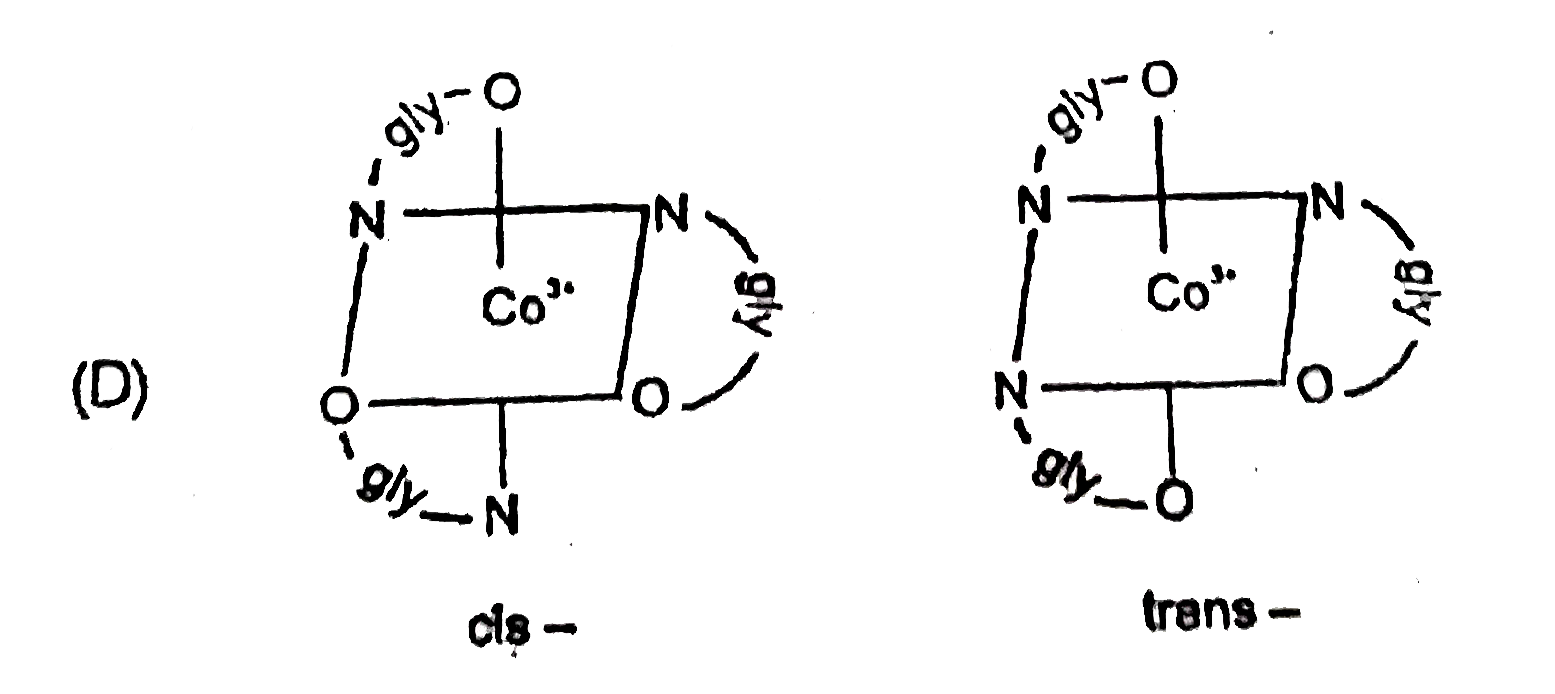InterviewSolution
This section includes InterviewSolutions, each offering curated multiple-choice questions to sharpen your knowledge and support exam preparation. Choose a topic below to get started.
| 11501. |
Which of the following metals has the largest abundance in the earth's crust ? |
|
Answer» Aluminium |
|
| 11503. |
Which of the following is not a use of dioxygen gas ? |
|
Answer» USEFUL in PREPARATION of STEEL |
|
| 11504. |
There are some coordination compounds given in column-I which may exist in different isomeric forms as given in column-II.Select the option for the coordination compounds and their respective isomeric forms. {:("Column-I","Column-II"),((A)[Co(en)_2NH_3Cl]SO_4,(p)"Optical isomer"),((B)[Co(NH_3)_4(NO_2)_2](NO_3),(q)"Geometrical isomer"),((C)[Co(en)(pn)(NO_2)_2]Cl,(r)"Ionization isomer"),((D )[Co(gly)_3], (s)"Linkage isomer"),(" " , (t)"Hydrate isomer"):} |
Answer»  Note: TRANS-form has a centre of symmetry and several planes of symmetry, but the cis-form has neither. (B)Has total 10-isomeric forms including linkage (`NO_2`- ambidentate ligand), ionisation (exchange of `NO_2^-` and `NO_3^-` ), geometrical isomers (cis- and trans-) Compound is optically inactive as cis-as well as trans-forms possess at least one PLANE of symmetry Linkage through either O- and N- give RISE to linkage isomerism.   Thus EXISTS in two trans-and two cis-isomers and each of cis-isomers show optical isomerism.  Both cis- and trans- isomers have each a pair of optical isomers because the absence of any one of symmetry ELEMENTS. |
|
| 11505. |
The recommended daily dose is 17.6 milligrams of vitamin C (ascorbic acid) having formula C_(6)H_(8)O_(6) Match the following . Given : N_(A)=6xx 10^(23) |
|
Answer» |
|
| 11506. |
Which compounds would undergo Cannizaro'sreaction? |
|
Answer» `underset(CH_(3))underset("|")overset(CH_(3))overset("| ")(CH_(3)-C-CHO)` |
|
| 11507. |
What are monohydric alcohols ? How are they classified ? |
|
Answer» Solution :Alcohols having only one hydroxyl group in their MOLECULES are called monohydric alcohols. Monohydric alcohols are classified according to the type of hybridization of th carbon atom to which the hydroxyl group is attached . (1) Alcohols containing`C_(sp^(3))-OH` bond : In these alcohols -OH group is attached to a `sp^(3)`hybridised carbon atom of alkyl group. These alcohols are represented as R-OH . They are further classified as primary , SECONDARY and tertiary alcohols in which -OH group is attached to primary , secondary , and tertiary carbon atoms respectively.  (a) Allylic alcohols : In these alcohols -OH is attached to a `sp^(3)`-hybridised carbon atom next to the carbon-carbon double bond i.e., to allylic caron. Allylic alcohol may be primary , secondary and tertiary alcohols.`{:(CH_(2)=CH-CH_(2)-OH""CH_(2)=CH-overset(CH_(3))overset(|)(CH)-OH""CH_(2)=CH-underset(CH_(3))underset(|)overset(CH_(3))overset(|)C-OH),("Allyl alcohol (primary)(secondary alcohol )(teritary alcohol)"),("prop-2-en-1-olbut-3-en-2-ol2-methylbut-3-en-2-ol") :}` (b) Benzylic alcohols : In these alcohols -OH group is attached to a `sp^(3)` -hybridised carbon atom next to an aromatic ring. Benzylic alcohol may be primary , secondary and tertiary alcohols.  (2) Alcohols containing `C_(sp)^(2)-OH` bond : In these alcohols -OH group is ttached to a `sp^(2)` hybridised carbon atom , e.g., vinylic carbon. These alcohols are ALSO called vinylic alcohols. |
|
| 11508. |
Which of the natural process is spontaneous |
|
Answer» Formation of curd from milk after doing initation |
|
| 11509. |
X_(m)Y_(n(s)) underset(H_2O)(hArr) mX_((aq))^(n+)+nY_((aq))^(m-) solubility product K_(sp) is |
|
Answer» `[X^(N+)]^m[Y^(m-)]^n` |
|
| 11510. |
Which one of the following high spin complexes has the largest crystal field stabilization energ? |
|
Answer» `[Cr(H_2O)_6]^(2+)` |
|
| 11511. |
Which of the following polymers is not correctly matched ? |
|
Answer» Formation of dacron-Step growth polmerisation |
|
| 11512. |
When methyl iodide is treated with ammonia, the product obtained is : |
|
Answer» Methylamine |
|
| 11513. |
What is the magnetic nature of manganate and permanganate ions. |
| Answer» Solution :Mananate ion is PARAMAGNETIC in nature with ONE unpaired ELECTRON and permanganate is DIAMAGNETIC in nature. | |
| 11514. |
Van Arkel method of purification of metals involves converting the metal to a: |
|
Answer» volatile STABLE COMPOUND. |
|
| 11515. |
The shape of methyl carbanion is similar to that of - |
|
Answer» `BF_(3)` |
|
| 11516. |
What is the E_(cell) Value of galvanic cell of redox reactions at equilibrium condition ? |
|
Answer» More than ZERO volt But when EQUILIBRIUM achieved than cell stops WORKING and so `E_(cell)=0.0V`. |
|
| 11517. |
What are analgesic medicines? How are they clasified and when are they commonly recommended for use? |
|
Answer» Solution :Analgesic medicines : The Chemicalsubstancewhich are used to RELIEVE pain is CALLED analgesic medicines. There are two TYPES ofanalgesic medicines (i) Non nacrotic drugs :These are effective in relieving skeletal pain, preventing heart attack and viral inflammation etc. (II) Nacrotic drugs :These are recommended for the RELIEF in postoperative pain, cardiac pain and terminal cancer. |
|
| 11518. |
The reagents for the following conversion is/are |
|
Answer» alcoholic KOH |
|
| 11519. |
The value of DeltaG ((KJmol^(-1)) for the given cell is : ( Taken 1F = 96500C mol^(-1) |
|
Answer» `(-5.7)` |
|
| 11520. |
Two pure liquids A & B which can from ideal solution have vapour pressures 300 torr & 800 torr . A mixture of the vapour of A & B for which the mole fraction of A is 0.25 is slowly compressed at temperature T. The total pressure when first drop of condensate formed will be |
|
Answer» 565 torr |
|
| 11521. |
The solubility ofa sparingly solute salt A_(2)B_(2) is 3.5xx10^(-8) at 30^(@)C and the vapour pressure of its saturated solution in water is 31.8 mm of Hg at 40^(@)C. Calculate the enthalpy change for the reaction. A_(2)B_(3)hArr 2A^(+3)+3B^(-2) Vapour pressure of pure water =31.9 mm Hg at 40^(@)C |
|
Answer» |
|
| 11522. |
Which of the following have the maximum boiling point ? |
|
Answer»
|
|
| 11523. |
The standard oxidation potentials of Zn, Cu, Ag and Ni electrodes are +0.76,-0.34,-0.80 and +0.25 V respectively . Which of the following reaction will provide maximum voltage ? |
|
Answer» `CU+2Ag^(+)(aq)toCu^(2+)(aq)+2Ag` (b)`E^(@)=0.76+0.80=1.56V` (C ) `E^(@)=-0.25V` (d)`E^(@)=0.76+.34=1.00V` (e )`E^(@)=0.76V` `therefore` Correct ANSWER (B) . |
|
| 11524. |
The substance having highest conductivity at room temperature among the following is |
|
Answer» 0.1 N HCl |
|
| 11525. |
The temperature dependence of the e.m.f. of a standard electrochemical cell is given by E=1.02-4.0xx10^(-5)(T-20)-9.0xx10^(-7)(T-20)^(2) where T is in .^(C) and E is in volts. Calculate the temperate coefficiency of the e.m.f. at 30^(@)C |
|
Answer» SOLUTION :`(DE)/(DT)=(d)/(dT)[1.02-4.0xx10^(-5)(T-20)-8.0xx10^(-7)(T-20)^(2)]` `=-0.4xx10^(-5)-9.0xx10^(-7)xx2(T-20)` `=-4.0xx10^(-5)-9.0xx10^(-7)xx2(30-20)` `=-4.0xx10^(-5)-9.0xx10^(-7)xx20` `=-4.0xx10^(-5)-1.80xx10^(-5)=-5.8xx10^(-5)V//.^(@)C` |
|
| 11526. |
Which of the following exists as an optical isomer ? |
|
Answer» `[Zn(EN)(NH_(3))_(2)]^(3+)` |
|
| 11528. |
Which of the following oxides is/are amphoteric ? |
|
Answer» `Na_(2)O` |
|
| 11531. |
The relationship between the value of Osmotic pressue (pi) of the solution obtained by dissolving 6 g.L^(-1)of acetic acid (pi_1) and7.45 g.L^(-1) of KCl (pi_2) is |
|
Answer» `pi_1 LT pi_2` |
|
| 11532. |
The reagent which can be used to distinguish acetophenone from benzophenone is : |
|
Answer» 2,4-dinitrophenyl HYDRAZINE |
|
| 11533. |
Which of the following is most effective for the hydrolysis of an ester? |
| Answer» Answer :A | |
| 11534. |
What is stoichiometric coefficient of Ca in the following reaction? Ca + Al^(3+) toCa^(2+) + Al |
| Answer» ANSWER :D | |
| 11535. |
Which of the following contains most basic nitrogen |
|
Answer»
|
|
| 11536. |
Which is used as a general anaesthetic in place of diethyl ether: |
|
Answer» `CF_3-CHClBr` |
|
| 11537. |
underset([Co(en)_(2)ClBr]NO_(2))(X) to "Isomer" A overset(AgNO_(3))to "Yellow ppt" B overset(AgNO_(3)) to "White ppt" C to exhibit facial meridonial Compound A many show |
|
Answer» IONISATION ISOMERISM |
|
| 11538. |
underset([Co(en)_(2)ClBr]NO_(2))(X) to "Isomer" A overset(AgNO_(3))to "Yellow ppt" B overset(AgNO_(3)) to "White ppt" C to exhibit facial meridonial How many total structure are possible for compound C ? |
|
Answer» 2 |
|
| 11539. |
Write the structure formula and IUPAC name of. (i) Iso - butyl chloride (ii) Tert - amyl bromide (iii) Sec-butyl chloride |
|
Answer» SOLUTION :(i) `OVERSET(3)(CH_(3))-UNDERSET(CH_(3))underset(|)overset(2)(CH)-overset(1)(CH_(2))-Cl` (1-Chloro-2-methyl propane) (II) `CH_(3)-underset(""^(3)CH_(2)^(4)CH_(3))underset(|)overset(""^(1)CH_(3))underset(|)(CH_(3))-Br` (2-Bromo-2-methyl butane) (iii) `underset("2-Chlorobutane")(overset(1)(CH_(3))-underset(Cl)underset(|)overset(2)(CH)-overset(3)(CH_(2))-overset(4)(CH_(3)))` |
|
| 11540. |
Which of the following is not condensation method for preparation of colloid sol ? |
|
Answer» Peptization |
|
| 11541. |
VitaminB _(2)is alsoknown as |
|
Answer» Riboflavin |
|
| 11542. |
Which of the following options are correct for [Fe(CN)_(6)]^(3-) complex ? |
|
Answer» `d^(2)SP^(3)` HYBRIDISATION |
|
| 11543. |
Which of the following graph represents melting points of the group - 15 elements is |
|
Answer»
|
|
| 11544. |
Which of the following is weakest acid |
|
Answer»
|
|
| 11545. |
When a mixture of solid NaCl, solid K_(2)Cr_(2)O_(7) is heated with conc. H_(2)SO_(4) orange red vapours are obtained. These are of the compound |
|
Answer» Chromous chloride `K_(2)Cr_(2)O_(7)+2H_(2)SO_(4)to2KHSO_(4)+2CrO_(3)+H_(2)O` `CrO_(3)+2HClto underset(("ORANGE red vapour"))(CrO_(2)Cl_(2))` |
|
| 11546. |
Which one is called Microcosmic salt? |
|
Answer» `Na_2HPO_4 . 2H_2O` |
|
| 11547. |
Which of the following carbanion is most stable ? |
|
Answer» `H_(3)C-overset(Theta)(CH_(2))` |
|
| 11548. |
Which of the following on reaction with NH_(3) gives urinary antiseptic compound |
| Answer» Answer :A | |
| 11549. |
What is optical activity ?Explain. |
| Answer» SOLUTION :Some COMPOUNDS have the ability to rotate the plane of plane POLARIZED light. This PHENOMENON is CALLED optical activity. | |